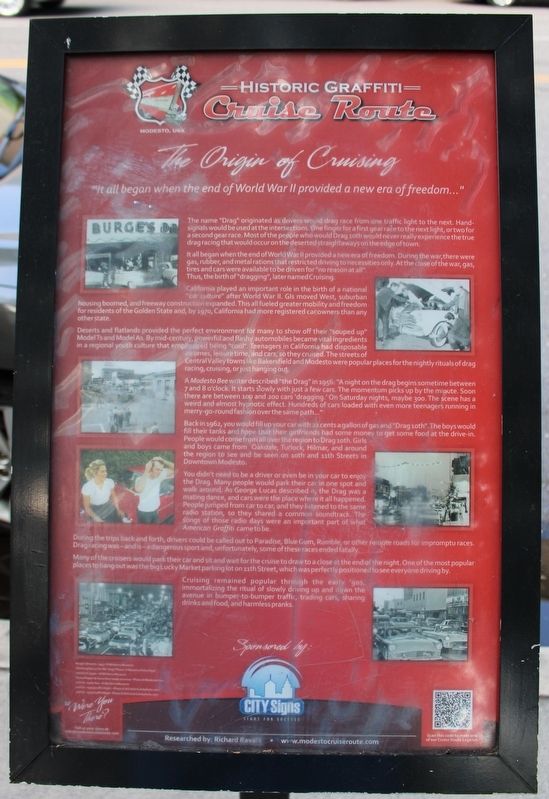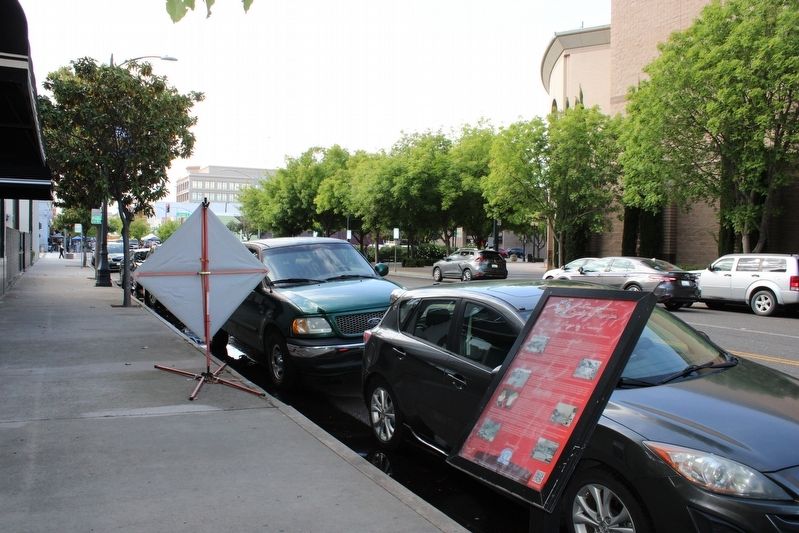Modesto in Stanislaus County, California — The American West (Pacific Coastal)
The Origin of Cruising
Historic Graffiti Cruise Route
— ”It all began when the end of World War II provided a new era of freedom…” —
It all began when the end of World War II provided a new era of freedom. During the war, there were gas, rubber, and metal rations that restricted driving to necessities only. After the close of the war, gas, tires and cars were available to be driven for “no reason at all.” Thus, the birth of “dragging”, later named cruising.
California played an important role in the birth of a national “car culture” after World War II. GIs moved West, suburban housing boomed, and freeway construction expanded. This all fueled greater mobility and freedom for residents of the Golden State and, by 1970, California had more registered car owners than any other state.
Deserts and flatlands provided the perfect environment for many to show off their “souped up” Model Ts and Model As. By mid-century, powerful and flashy automobiles became vital ingredients in a regional youth culture that emphasized being “cool”. Teenagers in California had disposable income, leisure time, and cars, so they cruised. The streets of Central Valley towns like Bakersfield and Modesto were popular places for the nightly rituals of drag racing, cruising, or just hanging out.
A Modesto Bee writer described “the Drag” in 1956: “A night on the drag begins sometime between 7 and 8 o’clock. It starts slowly with just a few cars. The momentum picks up by the minute. Soon there are between 100 and 200 cars ‘dragging.’ On Saturday nights, maybe 300. The scene has a weird and almost hypnotic effect. Hundreds of cars loaded with even more teenagers running in merry-go-round fashion over the same path…”
Back in 1962, you would fill up your car with 22 cents a gallon of gas and “Drag 10th”. The boys would fill their tanks and hope that their girlfriends had some money to get some food at the drive-in. People would come from all over the region to Drag 10th. Girls and boys came from Oakdale, Turlock, Hilmar, and around the region so see and be seen on 10th and 11th Streets in Downtown Modesto.
You didn’t need to be a driver or even be in your car to enjoy the Drag. Many people would park their car in one spot and walk around. As George Lucas described it, the Drag was a mating dance, and cars were the place where it all happened. People jumped from car to car, and they listened to the same radio station, so they shared a common soundtrack. The songs of those radio days were an important part of what American Graffiti came to be.
During the trips back and forth, drivers could be called out to Paradise, Blue Gum, Rumble, or other remote roads for impromptu races. Drag racing was – and is – a dangerous sport and, unfortunately, some of these races ended fatally.
Many of the cruisers would park their cars and sit and wait for the cruise to draw to a close at the end of the night. One of the most popular places to hang out was the big Lucky Market parking lot on 11th Street, which was perfectly positioned to see everyone driving by.
Cruising remained popular through the early ‘90s, immortalizing the ritual of slowly driving up and down the avenue in bumper-to-bumper traffic, trading cars, sharing drinks and food, and harmless pranks.
Were You There? Tell us your story at: [email protected]
Researched by: Richard Ravalli • www.ModestoCruiseRoute.com
Erected by Modesto Convention & Visitor's Bureau.
Topics and series. This historical marker is listed in this topic list: Roads & Vehicles. In addition, it is included in the Historic Graffiti Cruise Route series list. A significant historical year for this entry is 1970.
Location. 37° 38.337′ N, 120° 59.917′ W. Marker is in Modesto, California, in Stanislaus County. Marker is on 10th Street south of I Street, on the right when traveling south. The resin marker is mounted to a metal post at the sidewalk. Touch for map. Marker is in this post office area: Modesto CA 95354, United States of America. Touch for directions.
Other nearby markers. At least 8 other markers are within walking distance of this marker. Modesto City Offices (within shouting distance of this marker); Key Classic Cars (within shouting distance of this marker); Modesto Music Scene (within shouting distance of this marker); Downtown Culture, Arts & Music (about 400 feet away, measured in a direct line); The Music of American Graffiti (about 400 feet away); Hometown Heroes (about 500 feet away); The Car Customizers (about 500 feet away); Bart Bartoni - The Godfather of 10th St (about 500 feet away). Touch for a list and map of all markers in Modesto.
Also see . . . Modesto USA.
""American Graffiti" was the first big film from Modesto native George Lucas. This music-themed night on the town in 1962 lit a fire that created the nostalgia movement of the 1970s and ‘80s, leading to the resurgence of ‘50s music and hit TV series like "Happy Days;" and it all started right here in Modesto, USA."(Submitted on June 7, 2023, by Joseph Alvarado of Livermore, California.)
Credits. This page was last revised on June 8, 2023. It was originally submitted on June 7, 2023, by Joseph Alvarado of Livermore, California. This page has been viewed 192 times since then and 84 times this year. Photos: 1, 2. submitted on June 7, 2023, by Joseph Alvarado of Livermore, California.

